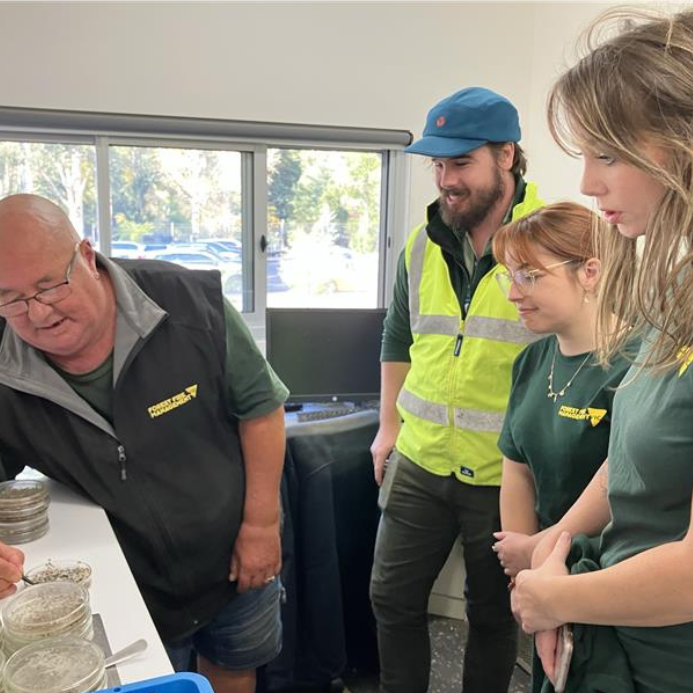
Alex (above) examines germinating seeds with (from left) Chloe Steadman, Natasha Carland and Jack Davis
Alex von Schlippe knew he was making an impact as a seed viability tester when he was no longer thought to be a phantom on the payroll.
“A lot of people thought I was a phantom on the payroll," he said. "The fact that I was alive was a surprise to some people.”
Alex’s role for the past 30 years, as DEECA's only native seed tester, is to test batches of seed sent from forests around Victoria to his laboratory, currently at Noojee. Each species has a specific testing regime and scientific protocols around it.
Alex initially worked in a nursery but started testing seed with Forestry Victoria, then the Department of Sustainability and Environment and moved across to VicForests for 12 years. He now works as a Forest Management Silvicultural Seed Tester with DEECA’s Forest Health and Recreation branch.
His shift to prominence reflects the value of seed and its important role in forest recovery.
*In 2024/25 as part of the Future Forests Program DEECA was provided with $8.5m to continue to collect, store and test seed in readiness to help the state’s forests recover from major events such as bushfires, and to support forest regeneration programs.
DEECA currently has 23 tonnes of selected seed species in store. It includes 6.5 tonnes of Alpine Ash and 5.5 tonnes of Mountain Ash.
Seed crops unpredictable
While seed might literally grow on trees, crops can be unpredictable.
Alex’s painstaking work makes sure the valuable seed still collected by hand isn’t wasted. Each batch is tested every 3 years.
His analysis tells foresters how viable or productive a seed lot is. This helps foresters ensure its not wasted when seed is taken from the seedbank to raise seedlings or to conduct sowing. The analysis informs them if the seed is being stored correctly, and how long it will take for the seed to germinate on the ground. It also tells foresters if the seed needs stratification.
“Each lot will be tested four times in a petri dish,” he said.
“The seed will have its own growth medium. They will be popped into a incubator where the seeds will start to grow. Some seeds like Snowgum and Alpine Ash need to be stratified. They are placed into a fridge at 4 degrees for 8 weeks to replicate the cold snowy conditions where they naturally occur.
“As each seed germinates, Alex counts and plucks it from the petri dish with tweezers. The batch is then classified.
“For an average to good seed lot of Alpine Ash you would expect to get 50 germinants per petri dish,” Alex explained. “In one batch of shining gum we had more than 500 germinates in one petri dish. “It was a good batch of seed.”
Testing reduces wastage
Alex also compares seed collected at different points in time.
“I recall during the drought about 15 years ago, seed was sparse and when we compared it later the batches it didn’t perform as well,” he said.
“In this case we knew why but when there is a difference between batches we ask why – is it due to climate change, long periods of drought and, warm winters?”
Alex has seen and appreciated the increased application of science and the introduction of a rigorous seed testing regime.
“In the early years there weren’t many tests done it wasn’t so much of a focus. With the introduction of VicForests seed crops were closely monitored, all seed was tested.
“How it’s stored has also been a major change.
“It’s made a big difference. “There is very little over sowing or under sowing which is beneficial for everyone. “The seed doesn’t get wasted and we end up with a good result.”
Page last updated: 20/08/25